Casio
PT-82,
Casio
PT-87,
Casio
EP-20 |
small keyboard
with ROM-Pack, key lighting & blip rhythm |
|
Casio PT-82
This keyboard from 1986 has many similarities with the Casio
VL-Tone
1 and PT-1, but includes
a "melody guide" key lighting feature for music teaching (not the
keys itself light up but a row of small LEDs above them) and a
ROM-
Pack music cartridge slot. Unfortunately this instrument is missing
the great built-in synthesizer, sequencer and 3 octave switch of the VL-Tone.
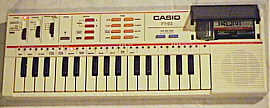
Although the music playback from the ROM- Pack includes wonderful polyphonic
accompaniments, the player can play own musics only monophonic with thin
and dull sounding blip rhythms. A bit unusual is that this white keyboard
has brightly coloured orange and red buttons and red lines while Casio
normally preferred pastel colours. Also a red case version of the PT-82
was made. In 1987 it was re-released in grey as
Casio
PT-87.
main features:
-
32 mini keys
-
built-in speaker (with unpleasant, loud mid-range resonance)
-
monophonic main voice
-
8 OBS preset sounds {violin, organ, harpsichord, piano, celesta, trumpet,
clarinet, flute}
-
12 preset rhythms {rock, disco, 16 beat, swing 2 beat, swing 4 beat, samba,
bossa nova, beguine, tango, march, slow rock, waltz}
-
volume switch (5 steps)
-
tempo +/- buttons (16 steps?)
-
ROM- Pack music cartridge slot for melody guide and "auto
play" (jukebox mode)
-
"melody guide" keyboard play training feature with key lighting (32 red
& green LEDs above the keys), 4 levels and automatic rating
-
2 "one key play" buttons (to step note by note through ROM musics)
-
semi- analogue sound generator similar like VL-1 (only monophonic
keyboard play, but additional 4 note polyphonic accompaniment during automatic
ROM music play). The digital envelopes (with audible zipper noise) are
linear and thus sounds unrealistic because they fade silent too soon.
-
rhythms consist of dull and distorted digital (squarewave?) blips + simple
shift register noise {base, low tom, high tom, snare, cymbal}
-
CPU= "HD61703B01, 5L 13"
-
tuning adjustment trimmer
-
headphone and power supply jack
notes:
The PT-82 was likely intended as a technically simplified successor
of the Casio PT-80. The speaker has
an unpleasant, loud mid- range resonance. The main voice sounds are the
same like with the PT-80, but tend to sound a little thinner and harsher.
These sounds resemble much a Casio VL-Tone
1; unfortunately they don't include the famous "fantasy" sound of the
latter. Although the musics from ROM- Packs play with nicely orchestrated
accompaniment, the player can play own musics only monophonic with a simple
rhythm and no accompaniment at all. Due to various other "Casio PT"
keyboards (e.g. PT-30 or PT-80)
had a set of additional buttons to the left of the keyboard to play chords,
I searched also for such keyboard matrix eastereggs, but yet found none.
The distorted percussion sounds a bit harsh, very colourless, and really
thin and boring (like when blip drums from a PT-30 keyboard would have
been resampled at an extremely low resolution and sample rate which removes
all dynamics). The rhythm patterns resemble the PT-80, but are not identical
(e.g. blip instead of popping base drum). Much like with the VL-Tone
1, the harpsichord sound suffers from a too slow attack rate, which
makes it unrealistic. In the plastic case of my PT-82 was an embossed mark
that seems to be the manufacturing date 86-02-08. The hardware is much
simpler than PT-80 and contains far less analogue components; with my PT-82
one of the red key lighting LEDs was faulty and had to be replaced.
When the instrument is switched on, it plays a tone scale (8 notes)
while a light runs from left to right on the LED chain. The instrument
was sold with the Casio ROM- Pack RO-551.
The ROM- Pack cartridge employs the same conductive carbonized silicone
rubber connector that is used in many LCD watch displays. (I had to clean
mine and the contact row on the PCB with isopropanol to make it function
reliable.)
More interesting is that the musics from it can be used with "melody
guide" training feature, in which a flashing LED (next key) and a lit
LED (current key) in the LED chain above the keys teach monophonic keyboard
play. It has 4 training levels {1= with light, waits for correct key, 2=
with light, no waiting, 3= without light, waits for correct key, 4= without
light, no waiting}. After finishing a piece of music, the player can press
the "rating" button to see how good he has played. To show this, a sort-of
"wheel of fortune" noise effect is played while a light runs multiple times
from left to right above the keys. The light turns slower and then stops
at a certain key. The better the player has played (less wrong noted and
timing flaws), the further right it stops with a short jingle that depending
on how good the player was {"* TRY AGAIN"= falling notes, "** FAIR"= very
disharmonic clip of "Unterlanders Heimweh", "*** GOOD"= fanfare, "****
EXCELLENT"= different fanfare}. As a sound effect, the rating jingles can
be also started by pressing the "rating" button while the mode switch is
set to "play" instead of "melody guide". In this case the melody guide
level select switch selects which of the 4 jingles is played.
Casio PT-87
This grey cased instrument was a re- release of the PT-82 from 1987. (Inside
the case embossed marks for 87 and {5, 6, 7, 8} make me conclude that it
was manufactured between may and august in 1987.) Unlike the PT-82, it
has the classical pale coloured Casio buttons again.
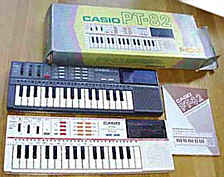 On
this photo from eBay you see my Casio PT-87 and my PT-82 (below). On
this photo from eBay you see my Casio PT-87 and my PT-82 (below). |
The PCB of this specimen contains less discrete components, the shielding
aluminium cardboard inlay is gone and the PT-87 has also no headphone jack
anymore. The CPU is "HD61703B01, 7D 33". My specimen has a strange defect;
when operated with batteries, it sounds distorted and howls, while with
a power supply it sounds perfect. Apparently the battery voltage (5 batteries
= 7.5V) is too low to operate the circuit properly - possibly a defective
voltage regulator drops too much voltage.
modifications:
-
Power supply jack polarity changed and protection diode added (with PT-82
and PT-87).
Casio EP-20 'Muppets'
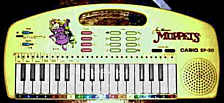 (photo from eBay, showing my specimen)
(photo from eBay, showing my specimen) |
Also this yellow toy keyboard is a mutilated Casio
PT-82. (Under the Muppets "Ms. Piggy" picture stands "© ha!
1987".) The power supply jack, tuning knob, "rating" button and "melody
guide" level switch are missing (level is always 1). Also the ROM cartridge
slot is gone, instead it has only a fixed soldered ROM chip "OKI MS268V-57,
7405" which contains 4 nicely orchestrated musics from the "Muppets" TV
series. An interesting technical detail is that this ROM apparently technically
contains 7 pieces of music, but the musics 2, 4 and 6 are empty files to
make the ROM use only the white keys for music selection. The CPU is "HD61703B01,
7D 33".
eastereggs:
As you can imagine, in the EP-20 the "rating" and melody guide level select
features are still present in the keyboard matrix of the CPU. To select
the level, a switch or push buttons needs to connect a diode from CPU pin
19 with pins 6, 7, 8, 9. The rating button connects a diode from pin 12
to pin 7. Theoretically certainly also a ROM- Pack could be added, but
this would be mechanically extremely difficult and not worth the effort.
| removal
of these screws voids warranty... |
|
|
 |

|
|
| |
back
|
|
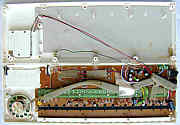

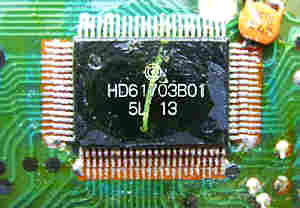
 On
this photo from eBay you see my Casio PT-87 and my PT-82 (below).
On
this photo from eBay you see my Casio PT-87 and my PT-82 (below). (photo from eBay, showing my specimen)
(photo from eBay, showing my specimen)